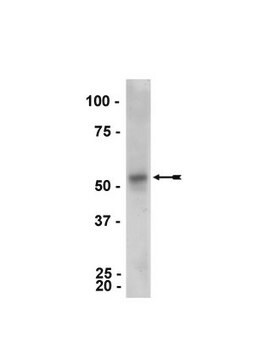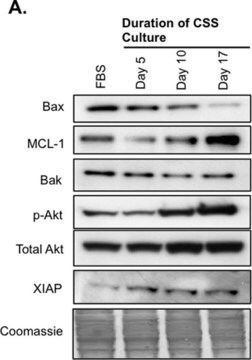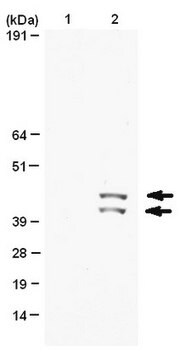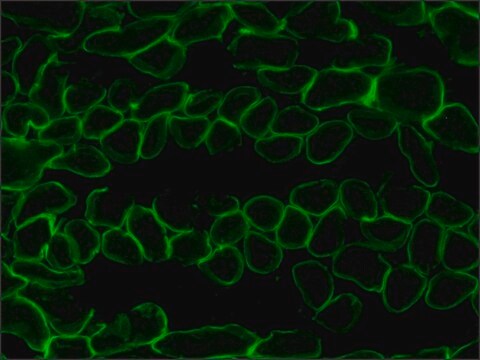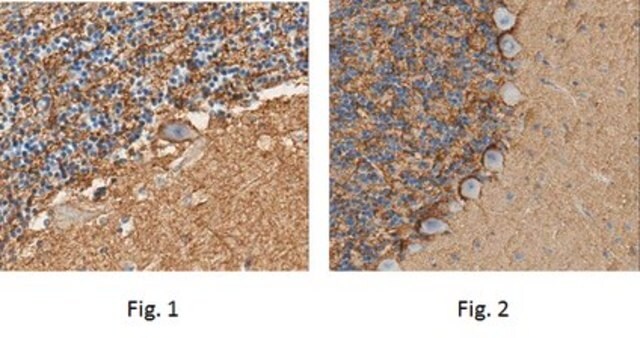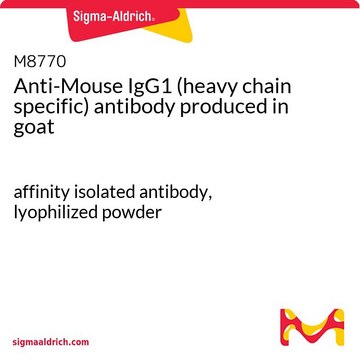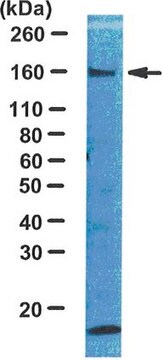15-107
MAPK Pathway 1 Explorer Antibody MiniPack
clone AW39R, 1 mg/mL (05-538SP), Upstate®
Synonym(s):
Oncogene RAF1, raf proto-oncogene serine/threonine protein kinase
About This Item
IF
WB
activity assay
multiplexing
flow cytometry: suitable
immunofluorescence: suitable
multiplexing: suitable
western blot: suitable
Recommended Products
clone
AW39R
Quality Level
species reactivity
mouse (05-538SP), Xenopus, chicken, human (05-538SP), rat
manufacturer/tradename
Upstate®
concentration
1 mg/mL (05-538SP)
technique(s)
activity assay: suitable (kinase and phosphatase)
flow cytometry: suitable
immunofluorescence: suitable
multiplexing: suitable
western blot: suitable
shipped in
dry ice
Gene Information
human ... MAP2K1(5604) , RAF1(5894)
General description
Each Pathway Explorer Antibody Minipack contains three related antibodies as part of a signaling cascade or a combination of total and phosphorylated forms of key signaling targets. Each of the three antibodies are 30% the original pack size. Full size versions of each of the Pathway Explorer antibodies are available for sale individually under the same catalog number with the removal of “SP” off of each one (e.g. 05-591SP can be ordered as 05-591).
Erk1/2:
Erk (Extracellular signal-Related Kinase) is a family of two, highly homologous proteins denoted as Erk1 (p44, MAPK3) and Erk2 (p42, MAPK1) that both function in the same pathway. The two proteins are often referred to collectively as Erk1/2 or p44/p42 MAP kinase. The Erk pathway is considered the classical, canonical MAPK (Mitogen-Activated Protein Kinase) signaling pathway. It is an evolutionarily conserved pathway that controls and is a critical regulator of the growth and survival through the promotion of cell proliferation and the prevention of apoptosis. Erk is involved in the control of many fundamental cellular processes including cell proliferation, survival, differentiation, apoptosis, motility and metabolism. Erk is activated by growth factor stimulation of receptor tyrosine kinases (RTKs), GPCR, and/or integrin stimulation. This activates the Ras-Raf-MEK-Erk pathway that results in the phosphorylation/activation of Erk1/2 (p44/p42) on the TxY motif (Thr202/Tyr204 and Thr185/Tyr187 for Erk1 & Erk2, respectively).
Raf:
The Raf proteins (A-Raf, B-Raf, Raf-1/c-Raf) are Ser/Thr kinases with homology to the PKC family, containing an N-terminal regulatory domain and a C-terminal catalytic domain. Raf (MAP Kinase Kinase Kinase) is the top kinase in the canonical MAPK pathway. Members of the Raf family bind to activated Ras. Ras, in its GTP-bound active state, activates the kinase activity of Raf. This results in Raf translocation to the plasma membrane and activation. Once activated, Raf then binds to and activates MEK (MAP Kinase Kinase) by phosphorylating it on the two residue motif. It is thought that B-Raf might be the predominant activator of MEK and that Raf-1 has a role in protection against apoptosis; a process that does not require either its kinase activity or its activation of MEK. The regulation of a large number of cellular processes are dependent upon the activation state of ERK, so the controlling of this pathway could have profound effects on various diseases. Activation of Raf-1 involves phosphorylation of Ser338/339 and Tyr340/341. Activating mutations of B-Raf that disrupt its auto-inhibition loop have been implicated in a number of cancers, including melanoma and colon cancer.
MEK1/MEK2:
MAP Kinase/Erk Kinase (MEK), alternatively known as MKK, is a true dual-specificity kinase, in that it phosphorylates the MAP kinases (Erk1/2; p44/p42)) on both the Thr and Tyr of the activation motif TEY. In vitro, the tyrosine phosphorylation is favored, whereas in vivo both phosphorylation events appear to occur simultaneously. This suggests that an additional factor is present in cells to facilitate the reaction. MEK1 and MEK2 are activated by phosphorylation of two serine residues (Ser218/222 in MEK1 and Ser222/226 in MEK2), which are substrates for the Raf family of kinases. Mutation of the phosphorylation sites from Ser to Asp creates a protein with constitutive kinase activity, which when expressed in cells is able to cause transformation.
* See full size versions for corresponding references.
Specificity
Immunogen
Application
Flow Cytometry Analysis:Jurkat cells were fixed, permeablized, and stained with anti-phospho-Erk 1/2 (Thr202/Tyr204, Thr185/Tyr187).
Signaling
Apoptosis & Cancer
MAP Kinases
Packaging
Components
05-747SP Anti-phospho-MEK1 (Ser218/222)/ MEK2 (Ser222/226)
05-797RSP Anti-phospho-Erk 1/2
(Thr202/Tyr204, Thr185/Tyr187), recombinant clone AW39R
Target description
Physical form
(Thr202/Tyr204, Thr185/Tyr187), recombinant clone AW39R
Storage and Stability
Handling Recommendations: Upon receipt, and prior to removing the cap, centrifuge the vial and gently mix the solution. Aliquot into microcentrifuge tubes and store at -20°C. Avoid repeated freeze/thaw cycles, which may damage IgG and affect product performance.
Analysis Note
05-538SP:3T3/NIH cells
Legal Information
Disclaimer
Storage Class Code
10 - Combustible liquids
Certificates of Analysis (COA)
Search for Certificates of Analysis (COA) by entering the products Lot/Batch Number. Lot and Batch Numbers can be found on a product’s label following the words ‘Lot’ or ‘Batch’.
Already Own This Product?
Find documentation for the products that you have recently purchased in the Document Library.
Our team of scientists has experience in all areas of research including Life Science, Material Science, Chemical Synthesis, Chromatography, Analytical and many others.
Contact Technical Service